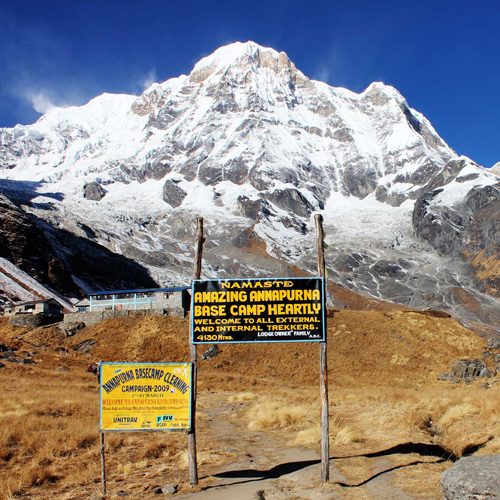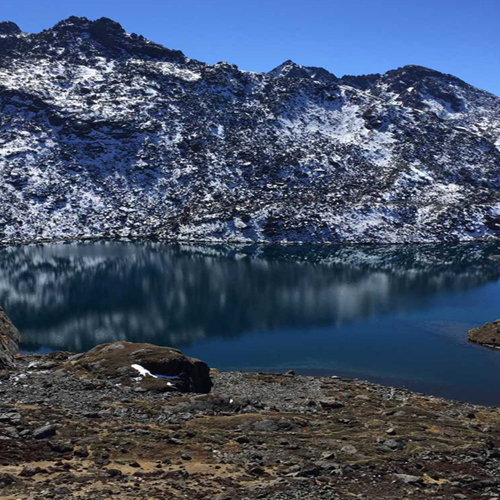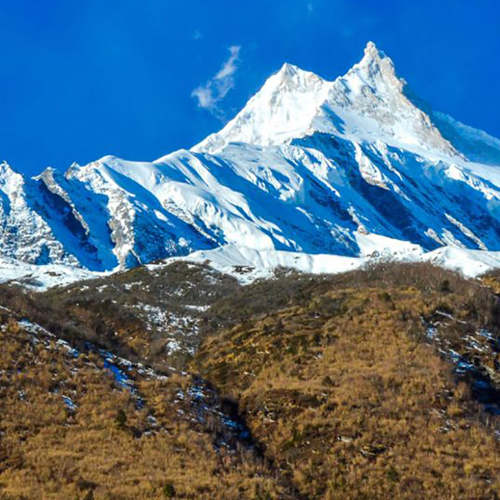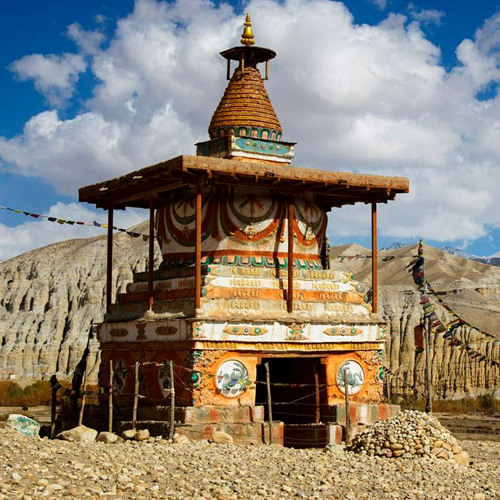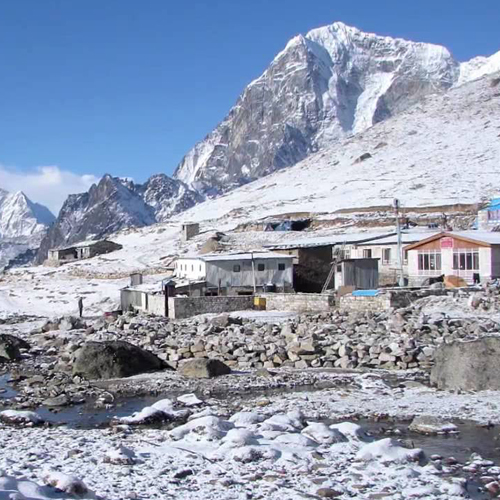Day 01: Arrive Paro (By Druk Air flight): (Paro Sightseeing)
Your tour guide representive from our company will receive you at the airport with Tashi Khadar and drive you the short distance to the hotel. After Tea, drive to Ta Dzong (built in1656 and renovated in 1968), an ancient watchtower, which now houses the National Museum. This unusual round building is said to be in the shape of a conch shell. The centerpiece of this Museum is a complex four-sided carving depicting the history of Buddhism and its propagation. One side is Sakyamuni and the great teacher Atisha, representing the Sakya School. On the next is Geylup, a disciple of Dalai Lama. Another is Nyingma lineage, the head is Guru Padmasanva, and the final is Drukpa Kagyu with the figure of Vajra Dhara. Below the museum is the Paro Rimpung Dzong (literally meaning “Heap of Jewels”, built in 1646 by Shabdrung Ngawang Namgyal, the centre of civil and religious authority in this valley. Here you can see finest example of Bhutanese architecture. Enroute visit Kichu Lhakhang, built in 659 A.D by the Tibetan king Srongsen Gampo. This Monastery is one of the 108 monasteries built across the Himalayan region by the Tibetan King to subdue the Demoness that lay across the Himalayan region. The rest of the monasteries lie in other neighboring countries. In the evening drive to the ruins of the Drukgyal Dzong, built in 1647 by the Great Shabdrung Ngawang Namgyal, father and unifier of medieval Bhutan, the dzong was destroyed by accidental fire and left in ruins as an evocative reminder of the great victories it was built to commemorate. Explore the ramparts and on a clear day experience an unforgettable view of Mt. Jhomolhari (7,314 m). Dinner and overnight in Hotel at Paro.
Day 02: Paro (Sightseeing) – Thimphu (Sightseeing):
After early breakfast, Excursion to Taktsang Monastery. A very special day, with an excursion to view the spectacular Taktsang (Tiger’s Nest) monastery – After breakfast a short drive takes us to Satsam Chorten, from there a 1 hr. walk till the viewpoint point of the monastery. The trail climbs through beautiful pine forest, many of the trees festooned with Spanish moss, and an occasional grove of fluttering prayer flags. We stop for a rest and light refreshments at the Taktsang Jakhang (cafeteria) and then walk a short distance until we see, clearly and seemingly within reach, Taktsang monastery. The primary Lhakhang was built around Guru Rimpoche’s meditation cave in the 1684by the Penlop of Paro Gyaltse Tenzin Rabgay, this incredible monastery clings to the edge of a sheer rock cliff that plunges 900 meters into the valley below. Legend has it that Guru Padmasambhava, the tantric mystic who brought Buddhism to Bhutan, flew here on the back of a flying tiger, Dorji Drolo, said to be his favourite consort. After lunch drive to Thimphu and visit the National Memorial Chorten (1974) built in honour of our late King Jigme Dorji Wangchuk, “The Father of Modern Bhutan”. Built in a typical Tibetan style, there are numerous religious paintings and the complex tantric statues reflecting both the peaceful and wrathful aspects of Buddhist deities. This Chorten is also a center of worship for the people living in Thimphu. Then visit to Dupthop Lhakhang one of the few surviving nunneries in Bhutan. Visit Changkha Monastery (This monastery was built in 15th century by the lama Phajo Drugom Zhipo) where the new born child of Thimphu valley are taken to receive 1st blessing from a High Lama. Drive to Mini Zoo where Takin, the national animal of Bhutan can be seen. This particular animal is found only in the Himalayan region and the head of this animal looks like that of a goat and body of a cow/yak and before sun set drive to Sangay gang view point (2685 meters) to have view of whole Thimphu valley and walk through hundreds of colorful prayer flags that dot the hill over looking the Thimphu valley. Dinner and Overnight in Hotel at Thimphu.
Day 03: Thimphu (Sightseeing):
After breakfast, visit the National Library, stocked with ancient Buddhist manuscripts, and the Painting School where traditional art is still kept alive through instructions in the art of painting Thangkas (sacred Buddhist religious scrolls).We can visit in different class rooms, where different students follows a comprehensive course that starts with drawing and progresses through painting, wood and slate curving, and statue making. Visit Traditional Medicine Institute where medicines are prepared according to ancient practices. Visit Handicraft Emporium for shopping Bhutanese Various Arts and Textiles. After lunch visit we will hike to Tango Monastery. The trail Tango is a climb of 280 meters and it takes an hour to reach the monastery. Lama Gyalwa Lhanampa founded the monastery in 12th century. The present building was built in 15th century by the “Divine madman”. This is one of the best places for meditation. In the evening, visit to the Tashichho Dzong (Fortress of the Glorious Religion). In 1216 the lama Gyalwa Lhanangpa built Dohon (Blue Stone) Dzong on the hill above Thimphu Where Dechen Phodrang now stands. A few years later Lama Phajo Drugom Shigpo, who brought the Drukpa Kagyu line age to Bhutan, took over Dohon Dzong. In 1641 the Zhabdrung (The one who unified the country) acquired the dzong from the descendants of lama Phajo and renamed it as Trashi Chhoe Dzong. He then arranged to house both monks and civil officials in the same Dzong. Present it is a seat of the national government and the Central Monastic Body, including the summer residence of the Je Khenpo (Chief Abbot of Bhutan). Dinner and overnight in Hotel.
Day 04: Thimphu – Punakha Sightseeing:
After early breakfast, drive to Punakha via Dochula Pass, where you can see 108 Bhutanese Stupas. If the weather is clear you can see all Himalays Ranges with all snow covered. Further drive to Punakha and visit Punakha Dzong. The Dzong is situated between the two rivers and it is one of the biggest rivers in Bhutan. We have to walk through the suspension bridge to reach the Dzong. The Dzong was built in 1637 by Shabdrung Ngawang Namgyal and is situated between Pho Chu (Male River) and Mo Chu (Female River). For many years until the time of the second king, it served as the seat of the Government. The construction of the Dzong was foretold by Guru Rimpoche, who predicted, “…a person named Namgyal will arrive at a hill that looks like an elephant”. There was a smaller building here called Dzong Chu (Small Dzong) that housed a statue of Buddha. It is said that Shabdrung ordered the architect, Zowe Palep, to sleep in front of the statue, while Palep was sleeping, the Shabdrung took him in his dreams to Zangtopelri and showed him the palace of Guru Rimpoche. From his vision, the architect conceived the design for the new Dzong, which in keeping with the tradition, was never committed to paper. The Dzong was named Druk Pungthang Dechen Phodrang (Palace of Great Happiness). The war materials captured during the battle with Tibetans are preserved here. Punakha is still the winter residence of Je-Khenpo and King Jigme Dorji Wangchuk convened the new national Assembly here in 1952. In the evening short hike to Chimi Lhakhang, which was built by Lama Drukpa Kuenley in 15th century. (This monk is popularly known as the Devine madman for his philosophy, “Salvation through sex”). He subdued the demons with his “Magical Thunder bolt”. The Temple is also known as “The Temple of Fertility”. Sterile women from far and wide come to this Temple to get blessed and an article about this temple also appeared in newspaper, The Washington Post some years back. Dinner and over night in Hotel at Punakha.
Day 5: Punakha – Wangduephodrang(Sightseeing) – Trongsa (Sightseeing):
After early breakfast, drive to Trongsa. Enroute sightseeing in the valley of Wangdiphodrang includes: visit to Wangdiphodrang Dzong built in 1638. Legend relates that as the people were searching for the site of the Dzong, four ravens were seen flying away in four directions. This was considered auspicious sign, representing the spread of religion to the four points of the compass. The Dzong is situated at the confluence of Mo Chu and Tang Chu rivers. Drive further and cross over Pelela Pass at 3250 meters. Lunch will be at Chendebji Restaurant. Visit the Chendebji Monastery. This Monastery is patterned after Swayambhunath in Kathmandu and was built in the 19th century by Lama Shida, from Tibet, to cover the remains of an evil spirit that was killed at this spot. Dinner and Overnight in Hotel at Trongsa.
Day 06: Trongsa (Sightseeing):
After breakfast, visit Trongsa Dzong, the most impressive dzong in Bhutan, built in its present form in 1644 by Chogyal Minjur Tempa, the official who was sent by Shabdrung to unify eastern Bhutan and enlarged at the end of the 17th century by Desi Tenzin Rabgay. Trongsa Dzong is the ancestral home of the present Royal Family and first two hereditary kings ruled Bhutan from this Dzong. Visit Ta Dzong (Previous watch Tower to the Dzong) and have the view of whole Trongsa valley including Dzong. If you are interested make a shot hike to the village and have good photograph. In The evening leisure time to go around the Trongsa Small Town. Dinner and over night in Hotel.
Day 07: Trongsa – Gangtey (Sightseeing) – Thimphu:
Early breakfast, drive to Wangdiphodrang via Gangtey. Lunch at Gangtey valley. It is one of the most beautiful glacial valleys of the Himalayas. Visit Gangtey Gompa from outside. Gyaltse Pema Thinley, the grandson and mind reincarnation of Pema Lingpa founded the Temple in 1613, and Tenzin Legpai Dhendup, the second re-incarnation, built the temple. The present Abbot, Kunzang Pema Namgyal is the ninth re-incarnation. It is a Nyingmapa monastery and is affiliated to other Nyingmapa monasteries including Tamshing in Bumthang. Explore Phobjikha valley, famous for the Black Necked Cranes during winter. These cranes are very rare and endangered and highly protected by the Government. These cranes fly to Phobjikha valley which is their winter Habitat. The Cranes circle three times in a clock-wise direction around the Gangtey Gompa as a reverence to the Monastery before landing in the valley. They repeat the same practice before flying back to Tibet in early Spring. You can watch the cranes. Enroute we will stop in different places for the photography and have the view of different valleys. Dinner and Overnight in Hotel at Thimphu.
Day 8: Thimphu – Paro: Departure:
Early breakfast, drive to Paro and Airport and farewell.

